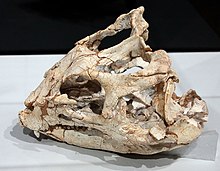Yinlong
| Yinlong | |
|---|---|

| |
| Fossil skull | |
| Scientific classification | |
| Domain: | Eukaryota |
| Kingdom: | Animalia |
| Phylum: | Chordata |
| Clade: | Dinosauria |
| Clade: | †Ornithischia |
| Clade: | †Ceratopsia |
| Family: | †Chaoyangsauridae |
| Genus: | †Yinlong Xu et al., 2006 |
| Species: | †Y. downsi
|
| Binomial name | |
| †Yinlong downsi Xu et al., 2006
| |
Yinlong (
Discovery and species
A coalition of
The known fossil material of Yinlong consists of many skeletons and skulls.
Description

Yinlong was a relatively small dinosaur, reaching 1.2 m (3.9 ft) in length and 10 kg (22 lb) in body mass.[3] Despite a virtually frill-less and totally hornless skull, Yinlong is a ceratopsian. Its skull is deep and wide and relatively large compared to most ornithischians, but also proportionately smaller than most other ceratopsians. Long robust hindlimbs and shorter slender forelimbs with three-fingered hands suggests a bipedal lifestyle like many small ornithopods.[1][3]
Classification
A small

| Ceratopsia |
| ||||||||||||||||||||||||||||||||||||||||||||||||||||||||||||||||||||||||||||||||||||||||||
Diet
Yinlong was discovered with seven
See also
References
- ^
- ^ a b c Holtz, Thomas R. Jr. (2011) Dinosaurs: The Most Complete, Up-to-Date Encyclopedia for Dinosaur Lovers of All Ages, Winter 2010 Appendix.
- ^ OCLC 985402380.
- ^ Zhao X., Cheng Z., & Xu X. 1999. "The earliest ceratopsian from the Tuchengzi Formation of Liaoning, China." Journal of Vertebrate Paleontology 19(4): 681-691.
- ^ Cooper, M.R. 1985. "A revision of the ornithischian dinosaur Kangnasaurus coetzeei Haughton, with a classification of the Ornithischia." Annals of the South African Museum 95: 281-317.
- ^ You H., Xu X. & Wang X. 2003. "A new genus of Psittacosauridae (Dinosauria: Ornithopoda) and the origin and early evolution of marginocephalian dinosaurs." Acta Geologica Sinica (English edition) 77: 15–20.
- S2CID 90051025.
External links
- GW News Center, featuring a link to the original paper, pictures, and a press release on the discovery of Yinlong (site operated by George Washington University)
